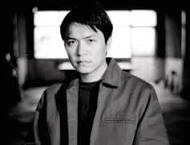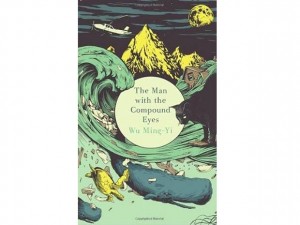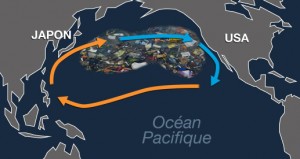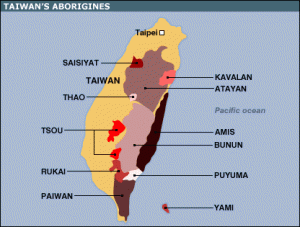 It has been mentioned for a long time that huge amounts of plastic waste were floating on the oceans. This rubbish is concentrated in areas where different ocean currents converge. Since 1997, several scientific expeditions have identified an area of several million km2 in the Pacific Ocean 1000 km north of Hawaii (1); the dustbin of our consumer society …
It has been mentioned for a long time that huge amounts of plastic waste were floating on the oceans. This rubbish is concentrated in areas where different ocean currents converge. Since 1997, several scientific expeditions have identified an area of several million km2 in the Pacific Ocean 1000 km north of Hawaii (1); the dustbin of our consumer society …
An island of plastic waste is one of the major themes of a pleasant novel ” The Man with the compound eyes ” by the Taiwanese writer Wu Ming -yi .
1- In 2029 , a tsunami of plastic ..
Nothing futuristic either in technology or in the lifestyle in 2029 but the environment of the east coast of Taiwan has strongly deteriorated . This is one of the achievements of the author as to merge a dream like novel with acute political awareness of the lack of interest of society vis-à -vis the environment and the risks to Taiwanese identity .
This is obviously a book about the relationship between man and nature, but also on the aborigines of Taiwan and their difficult encounter with modernity. The role of aboriginal civilizations in Taiwan has become an important issue for a new generation of novelists with a major book, “Survivors ” by Wuhe ( 2).
 The novel by Wu Ming -yi takes us in parallel on two islands, Wayo Wayo, an idyllic atoll of the South Seas and the east coast of Taiwan. In Wayo Wayo, insufficient resources are such that the second son of each family, at the age of fifteen, must build a boat and go without hope of return. Atilei therefore leaves the island and his fiancee Rasula; a storm leads him to land on a curious floating island, heaps of waste.
The novel by Wu Ming -yi takes us in parallel on two islands, Wayo Wayo, an idyllic atoll of the South Seas and the east coast of Taiwan. In Wayo Wayo, insufficient resources are such that the second son of each family, at the age of fifteen, must build a boat and go without hope of return. Atilei therefore leaves the island and his fiancee Rasula; a storm leads him to land on a curious floating island, heaps of waste.
In Taiwan, Alice Shih is considering suicide; she left college and spent ten years on the east coast with her husband, a Danish, Thom Jacobson, an avid mountaineer who, with their young son Toto, disappeared during a climb in the mountains. Sometimes the relations in the couple betweenTaiwanese and Danish certainly facilitates the identification for the Western reader who is also fascinated by the different indigenous tribes who live very close to the couple .
The book shows us the difficult relations between the Han Chinese and the aboriginal and is an indirect and subtle criticism of the lack of policy in Taiwan in favor of the environment, particularly on this endangered part of the coast.
2 Alice and Atilei
 This island of waste is pushed toward the shore by winds and currents; millions of tons, a plastic tsunami which destroys villages. Alice is injured, but while searching for elements of her house, she sets free from the garbadge a teenager, Atilei, and looks after his broken leg. But they do not speak the same language and understand each other will be difficult…
This island of waste is pushed toward the shore by winds and currents; millions of tons, a plastic tsunami which destroys villages. Alice is injured, but while searching for elements of her house, she sets free from the garbadge a teenager, Atilei, and looks after his broken leg. But they do not speak the same language and understand each other will be difficult…
The novelist gives us a good picture of Alice who after contemplating suicide will regain confidence with the contact of Atilei and several aborigines. A sophisticated composition with different styles when Atilei takes the lead after Alice .
Aborigines continue their search to find Toto. Other Danish characters join: a tunnel builder who will not be able to prevent more accidents on his building site and his wife Sara who came to survey the impact of the rubbish on the coast of Taiwan. Aboriginal Pangcah clean beaches but with this waste a part of their culture is dead; “for the Chinese, all this pollution means that there is more money to collect from the sea, but for the Pangcah it is different, the sea is their ancestor .”
Then comes a character which is not really needed, the man ” with the compound eyes “. He meets Thom, dying after his accident in the mountains. Everything becomes confused and the ending is not convincing! But Atilei will build his boat despite Alice sadness to try to find Rasula … Our pleasure will not be wasted and until the end we will be fascinated by these characters, the charm of this story and this reflection on the seventh continent.
3 – Wu Ming -yi , a “green” novelist
 Forty-three years old, after studying literature, he developed a passion for the island butterflies and becomes the scientific reference on the subject. An environmental activist, he published a book on the links between coastal populations and rivers of the island and will fight against a petrochemical plant project on the east coast that will eventually be scrapped.
Forty-three years old, after studying literature, he developed a passion for the island butterflies and becomes the scientific reference on the subject. An environmental activist, he published a book on the links between coastal populations and rivers of the island and will fight against a petrochemical plant project on the east coast that will eventually be scrapped.
He wrote five novels. The first one is a key to the history of Taiwan and the Japanese occupation “Routes in a dream” This novel so as the following has been translated into French by Gwennaël Gaffric who is pursuing studies on Taiwanese literature .
Wu Ming -yi was one of the first in Taiwan to be represented by an agent who has managed to sign with Rebecca Carter, one of the English publishers who helped a lot the development of Chinese literature in English speaking countries. The English version of “The man with the compound eyes”, published in August 2012 has attracted great interest .
Hopefully the last book by Wu Ming -yi, ” The magician on the bridge ” will be translated in a not too distant future. He recalls his childhood with his seven brothers and sisters in a small shoe store in a shopping mall in Taipei. The first chapters were translated into English by David Haysom ( http://www.spittingdog.net/2014/03/30 ) , a beautiful text .
Bertrand Mialaret
( 1 ) http://en.wikipedia.org/wiki/Great_Pacific_garbage_patch
( 2 ) https://mychinesebooks.com/frwuhe-nous-prsente-les-survivants-dun-drame-de-la-colonisation
Wu Ming -yi : ” The man with compound eyes”, translated into French by Gwennaël Gaffric . Stock February 2014. 360 pages, 22 euros.
Wu Ming-yi: “The man with the compound eyes”, translated into English by Darryl Sterk. Harvill Secker,2013.
Wuhe , “The Survivors” , translated into French by Emmanuelle Péchenart and Esther Lin- Rosolato . Actes Sud in 2011 , 295 pages , 23 euros.





